Did you know that over 50% of dogs in the United States are considered overweight or obese? With so many dogs struggling with weight issues, it’s important to find fun and challenging ways to keep them active and healthy.
That’s where agility training comes in – not only is it a great way to exercise your pup, but it’s also tons of fun for both of you! Agility training involves teaching your dog to navigate through a series of obstacles such as jumps, tunnels, and weave poles in a set amount of time. It’s a high-energy, fast-paced sport that requires both physical and mental agility from your furry friend.
And the best part? It’s suitable for dogs of all ages, sizes, and breeds! In this article, we’ll explore the many benefits of agility training and provide you with tips on how to get started, as well as some basic and advanced obstacles to try with your pup.
So, grab some treats and let’s get started on this exciting journey of agility training!
Key Takeaways
– Agility training is a fun and challenging way to keep dogs active and healthy, benefiting their physical and mental agility.
– Preparation is important, including finding a suitable training facility, using positive reinforcement techniques, and gradually introducing obstacles.
– Basic agility obstacles include jumps, tunnels, and weave poles, with advanced obstacles such as the A-frame and Teeter-totter available for high energy dogs.
– Agility training can be incorporated into everyday walks and DIY obstacles can be created, but always supervise the dog and start with lower obstacles before advancing.
Benefits of Agility Training for Your Dog
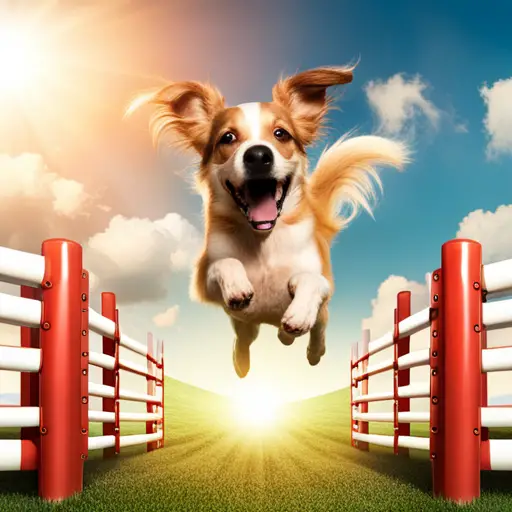
Agility training isn’t just a fun activity for your dog, it also has numerous benefits that can improve their physical and mental health!
One of the biggest advantages of agility training is that it helps improve your dog’s coordination. As they maneuver through the obstacles, they have to learn how to balance their body and use their limbs in different ways. This can be especially beneficial for younger dogs who are still developing their motor skills.
But agility training isn’t just about physical benefits. It also provides mental stimulation and problem-solving skills for your pup. As they navigate through the course, they have to think on their feet and figure out the best way to approach each obstacle. This type of mental exercise can help keep your dog’s mind sharp and engaged, reducing the risk of boredom or destructive behavior.
So, if you’re looking for a way to improve your dog’s physical and mental well-being, agility training is definitely worth considering!
Now that you know about all the great benefits of agility training, you may be wondering how to get started. Luckily, it’s easier than you think! Just start by finding an agility class near you or setting up your own course in the backyard. With a little bit of practice and patience, you and your furry friend will be navigating the obstacles like pros in no time!
Getting Started with Agility Training
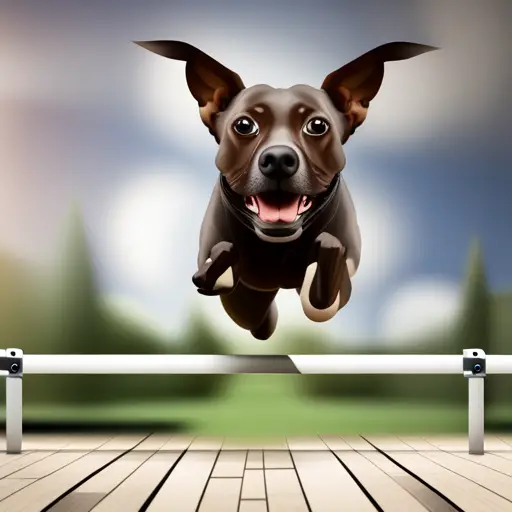
So, you’ve decided to get started with agility training for your pup! The first step is to find a training facility that offers agility classes.
Once you’ve found a suitable location, you’ll need to invest in some basic equipment such as jumps, tunnels, and weave poles.
Additionally, it’s important for your dog to have a solid understanding of basic commands such as ‘sit,’ ‘stay,’ and ‘come’ before beginning agility training.
Finding a Training Facility
You can easily find a training facility that suits your dog’s needs and your budget. There are many options available, from large franchise facilities to local mom-and-pop operations. When choosing a training facility, it’s important to consider the right trainer for your dog.
Look for a trainer who has experience working with your dog’s breed and age group, and who uses positive reinforcement techniques. Also, consider the cost of the training program. Some facilities offer group classes or private sessions, and the cost can vary depending on the level of training your dog needs.
Imagine feeling excited as you discover a local training facility that offers a free trial session for your furry friend. This is a great way to get a feel for the facility and see if it’s a good fit for your dog.
Once you’ve found a training facility, the next step is to gather the equipment needed for training. This includes things like agility jumps, tunnels, and weave poles. With the right training facility and equipment, you and your dog can start your agility training journey with confidence and enthusiasm.
Equipment Needed for Training
Get ready to set up a thrilling obstacle course for your pup by gathering all the necessary equipment. Some of the must-have equipment for agility training includes tunnels, weave poles, and jumps.
But there are also optional items you can consider, such as a seesaw, A-frame, and tire jump. When setting up your course, keep in mind the importance of safety measures during agility training. Make sure the equipment is stable and secure, and that your dog is always supervised and wearing a well-fitting harness.
To ensure your dog’s safety, it’s also important to invest in some additional equipment. Consider purchasing non-slip mats to place under the equipment to prevent slipping and falling. You can also use cones to mark the course and provide visual cues for your dog.
Don’t forget to have plenty of water and treats on hand to reward your pup for their hard work. With the right equipment and safety measures in place, your dog will be ready to tackle any obstacle you put in their way.
Now that you have the equipment set up, let’s move on to learning some basic commands your dog should know for agility training.
Basic Commands Your Dog Should Know
It’s essential that your furry friend knows basic commands before attempting any obstacle course, but don’t worry, these commands are easy to teach and will make the experience more enjoyable for both you and your pup.
The basic commands that your dog should be familiar with are sit, stay, come, and heel. These commands will provide the foundation for your dog’s training and will help you communicate with your furry friend effectively.
When teaching these commands, it’s important to use positive reinforcement training techniques, such as treats, praise, and playtime. Avoid using punishment-based training methods, as they can damage the relationship between you and your dog.
One of the common mistakes that pet owners make is trying to rush through the training process. Remember that each dog is unique and requires a different amount of time to learn new commands. With patience and persistence, your dog will be able to master these basic commands and be ready to tackle the agility obstacles that await.
As your dog becomes more proficient in these basic commands, you can move on to teaching more advanced agility training techniques.
The next section will cover the basic agility obstacles that you can set up in your backyard or at the park.
Basic Agility Obstacles
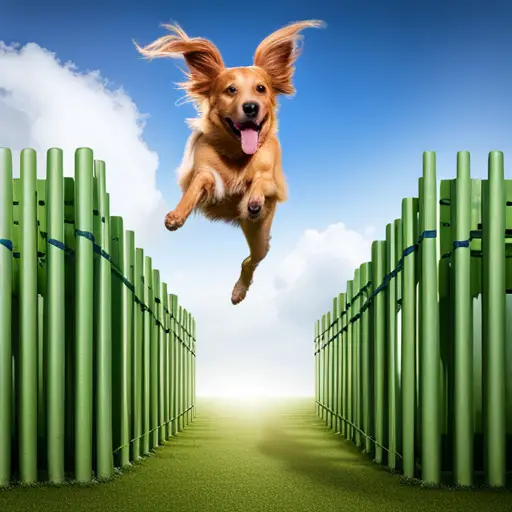
So, you’ve decided to start agility training with your dog. Great choice!
One of the most exciting aspects of agility training is getting to work with the different obstacles. In this subtopic, we’ll be discussing the three basic agility obstacles: jumps and hurdles, tunnels, and weave poles.
These obstacles will challenge your dog’s agility, speed, and accuracy, while also providing a lot of fun and fulfillment for both you and your furry friend.
Jumps and Hurdles
You’ll love seeing your pup’s excitement as they jump over hurdles and soar through the air during agility training. Jumping techniques and hurdle placement are important aspects of this subtopic.
When it comes to jumping, dogs can use a variety of techniques such as the ‘two feet together’ jump or the ‘one foot in front of the other’ jump. It’s important to find out which technique works best for your pup and adjust the hurdle placement accordingly.
Hurdles can be placed in different configurations, such as in a straight line or in a zigzag pattern, to challenge your dog’s agility and coordination. As your dog gains confidence and skill, you can gradually increase the height of the hurdles.
Remember to always supervise your dog during training and to never force them to jump over a hurdle if they are not comfortable doing so. Now, let’s transition into the subsequent section about tunnels.
Tunnels
Get ready to experience the thrill of watching your furry friend speed through a twisting, turning tunnel like a rocket! Tunnel techniques can be challenging to master, but once your pup gets the hang of it, they’ll love it! Here are some tips to get you started:
– Start with a straight tunnel: This will help your dog get used to the idea of running through a tunnel without any turns or twists.
– Add curves and angles gradually: Once your dog is comfortable with the straight tunnel, start adding some curves and angles to make it more challenging.
– Use a target: Place a target at the end of the tunnel to encourage your dog to run all the way through.
– Practice safety: Make sure the tunnel is secure and stable before your dog enters, and supervise them at all times to ensure their safety.
Now that your pup has mastered the tunnel, it’s time to move on to the next challenge: weave poles.
Weave Poles
Once your furry friend has mastered the tunnel, they can weave through a series of poles like a slalom skier in the snow. Weave poles are a fundamental obstacle in agility training that require your dog to enter and exit the poles in a specific pattern. To help your dog master this technique, there are a few tips you should keep in mind.
First, start with a small set of weave poles and gradually increase the number as your dog becomes more comfortable with the obstacle. Next, use positive reinforcement techniques such as treats and praise to encourage your dog to complete the weave poles correctly. Finally, incorporate weave poles into a routine to help your dog develop muscle memory and improve their agility skills. With these weave pole techniques, your furry friend will be weaving through the poles like a pro in no time.
As your dog becomes more proficient in agility training, it’s time to introduce them to advanced agility obstacles. These obstacles will challenge your dog’s physical and mental abilities, and push them to become even more agile and skilled.
Advanced Agility Obstacles
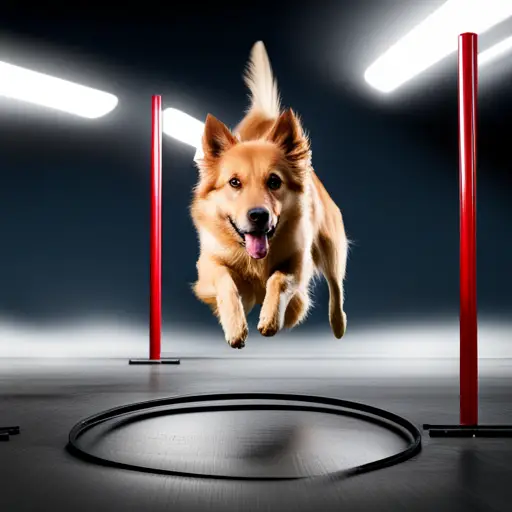
Although some may think that advanced agility obstacles are too difficult for their dogs, with proper training and practice, they can provide a fun and exciting challenge for both the dog and owner.
In dog agility competitions, advanced obstacles are often included to test the skills of highly trained dogs. If you’re looking for a way to take your agility training to the next level, here are four advanced obstacles to try with your high energy dog:
1. A-frame: This obstacle is a tall, narrow ramp that your dog must climb up and then descend on the other side.
2. Teeter-totter: This seesaw-like obstacle requires your dog to run up one end and balance until it reaches the ground on the other side.
3. Tunnel chute: This obstacle is a long, curved tunnel that ends in a chute, requiring your dog to navigate through the tunnel and then slide down the chute.
4. Jump combinations: These challenging sequences require your dog to jump over multiple obstacles in a specific order, testing their ability to follow commands and make quick decisions.
With practice and patience, these advanced obstacles can be a rewarding addition to your agility training routine. However, it’s important to remember that not all dogs are suited for advanced agility training.
In the next section, we’ll explore agility training for all dogs, regardless of their skill level or energy level.
Agility Training for All Dogs
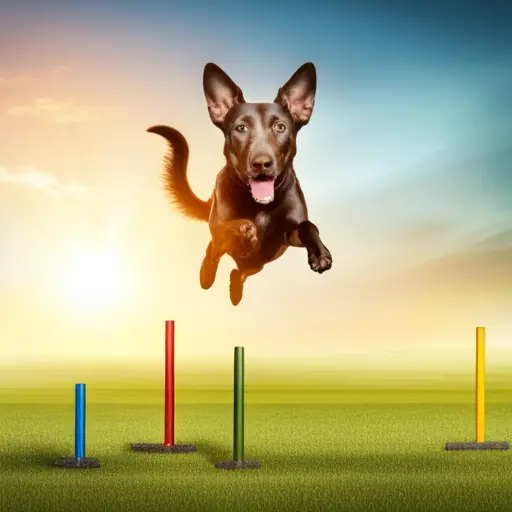
You can create a thrilling experience for your furry friend by incorporating agility training into their everyday walks. You don’t need a fancy agility course to get started. Simply use objects around your neighborhood like benches, stairs, and fallen logs to create mini-obstacles for your dog to navigate.
When walking on a sidewalk, make your dog walk on the curb or balance on a low wall. These activities will help improve their balance and coordination.
If you have access to a backyard or indoor space, there are many agility equipment options that can provide a challenging workout for your dog. Tunnels, hurdles, and weave poles are popular choices for agility training. If you don’t want to invest in equipment, you can create your own DIY obstacles using PVC pipes and pool noodles.
Just remember to always supervise your dog during agility training and start with lower obstacles before working your way up to more advanced challenges. With a little creativity and effort, you can help your dog become more agile and have fun while doing it!
Conclusion
So now you know all about agility training for your dog. You understand the benefits of this fun and challenging workout, and you’ve learned about the basic and advanced obstacles your dog can tackle.
Remember, agility training is not just for certain breeds – any dog can enjoy this activity! But there’s something deeper to consider here.
Agility training is not just about exercise or entertainment. It’s about building a strong bond between you and your dog. It’s about fostering trust, communication, and teamwork.
So as you embark on this journey with your furry friend, remember to focus on the journey itself, not just the destination. Cherish the time you spend together, and enjoy the process of learning and growing as a team.
Happy training!
